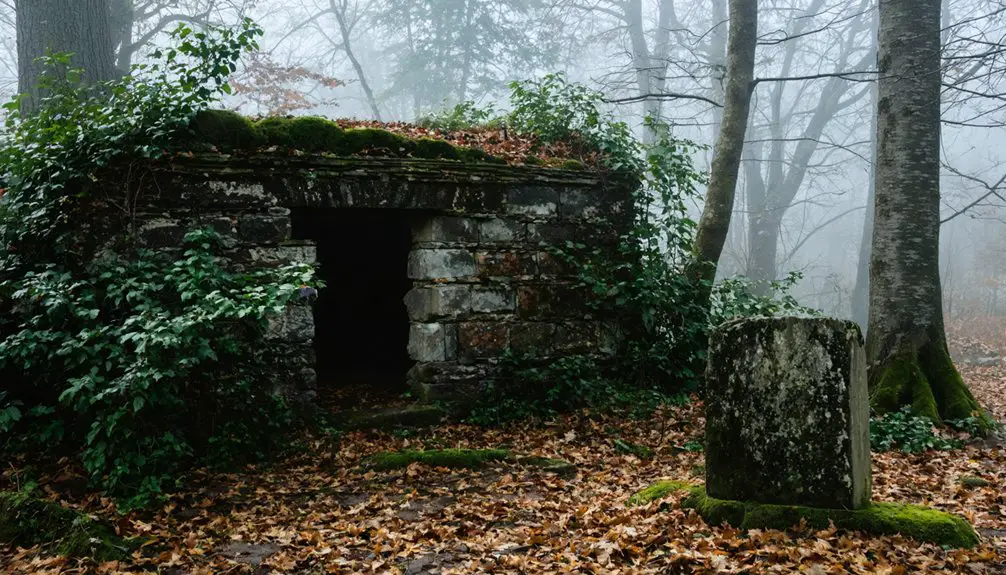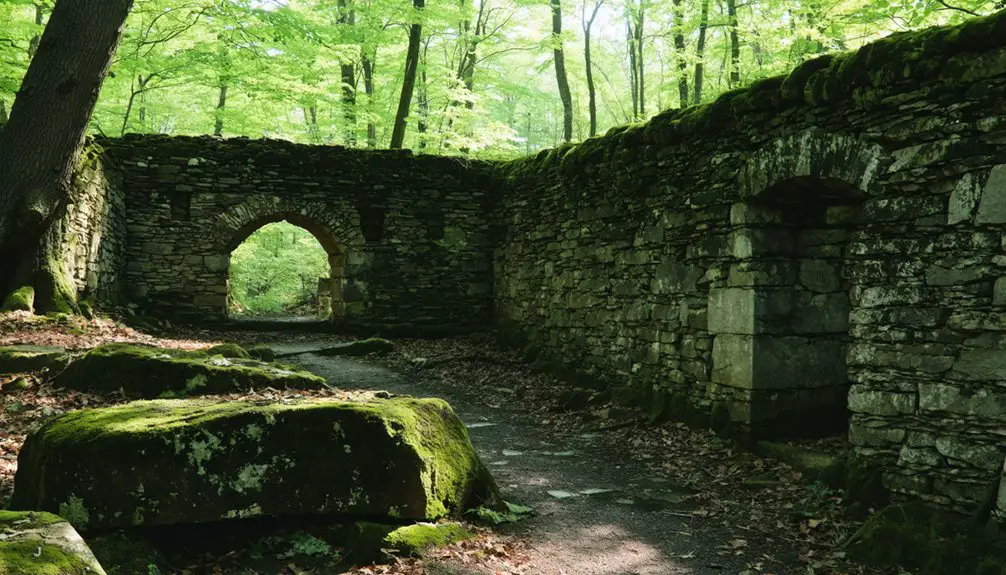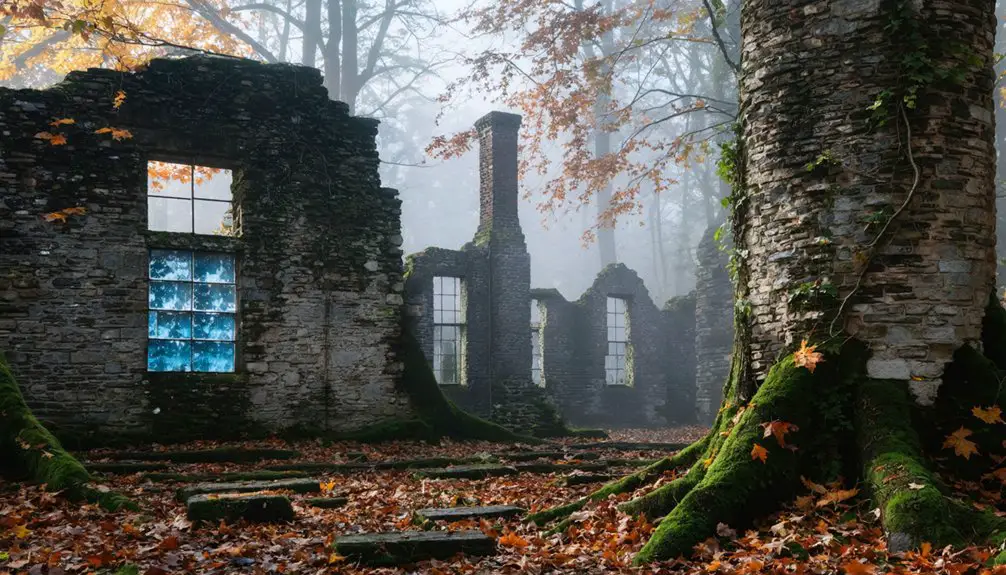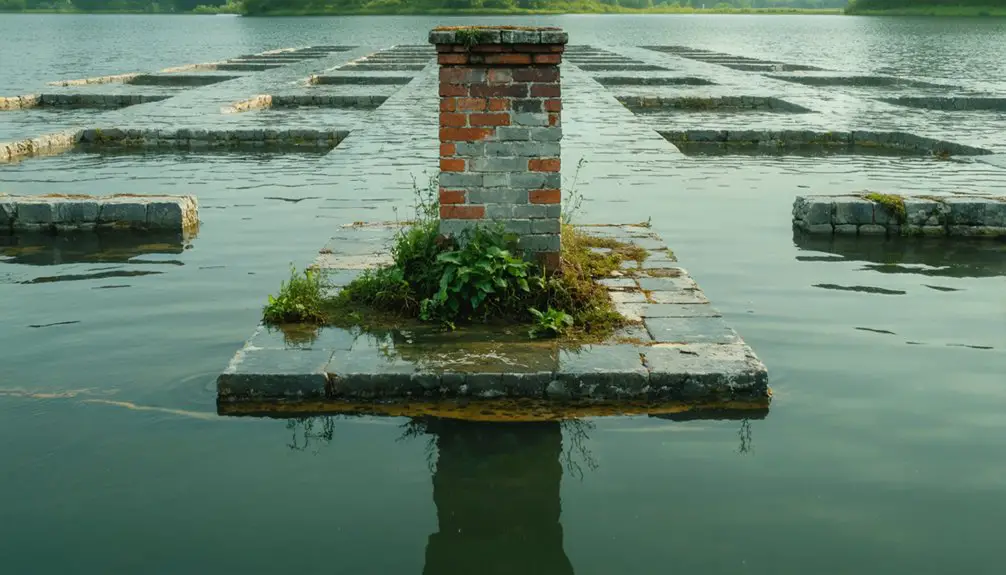You’ll find the remnants of Dogtown, Massachusetts, in 3,600 acres of woodland between Gloucester and Rockport. Founded in 1693 as a secure inland settlement, this thriving community once housed 100 families who raised livestock and harvested timber. After the Revolutionary War, the town gradually declined as residents moved to coastal areas, leaving behind war widows and social outcasts. By 1828, the last resident departed, transforming Dogtown into a mysterious landscape of cellar holes, ancient stone walls, and haunting legends.
Key Takeaways
- Established in 1693, Dogtown was a thriving inland settlement between Rockport and Gloucester that housed up to 100 families at its peak.
- The community declined after the Revolutionary War when new Boston roads bypassed the town and deforestation depleted vital resources.
- By 1828, Dogtown was completely abandoned, transforming from a bustling settlement into a ghost town with only cellar holes remaining.
- Today, the site spans 3,600 acres of wooded parkland featuring historic ruins, ancient stone walls, and the famous Babson Boulders.
- Local folklore associates Dogtown with witchcraft, paranormal activity, and ghostly encounters, stemming from its isolated location and marginalized former residents.
The Birth of a Common Settlement (1693)
When pirates and hostile native groups threatened coastal settlements in Massachusetts, a group of colonists established the “Common Settlement” in 1693, positioning their new community five miles inland on Cape Ann. The settlement origins reflected the colonists’ desire for security while maintaining access to crucial resources.
You’ll find that these early settlers chose a rocky, hilly terrain spanning roughly 5 square miles – land that wasn’t suitable for traditional farming but proved excellent for livestock grazing.
The early governance focused on managing shared resources, particularly the surrounding pine forests that provided essential timber for construction. The area’s abundant pine trees offered natural protection and building materials for the growing community.
Before permanent homes appeared in the early 1700s, the land served communal purposes, with residents sharing wood-harvesting areas and grazing fields for their cattle and sheep. At its height, the thriving community supported one hundred families, making it a significant settlement in the region.
Life in Early Dogtown: A Thriving Highland Community
You’ll find early Dogtown’s pioneer families built a resilient community on the highlands between Rockport and Gloucester, where they shared natural resources like pine forests and Alewife Brook’s water.
The settlement’s 75-100 homes housed about 80-100 families who relied on livestock raising and wood harvesting, creating a relatively affluent inland society compared to other Cape Ann communities. Archaeological evidence shows that Indigenous peoples inhabited this area for over 12,000 years before colonial settlement began.
Women played an essential role in maintaining the community, especially during the Revolutionary War when they stayed behind with their dogs while men served, leading to the settlement’s eventual name. The families originally settled in this location seeking refuge from pirates and Native American attacks along the coast.
Hardy Pioneer Settlement Life
The hardy pioneers who established Dogtown in 1641 chose their inland settlement location strategically, seeking protection from coastal storms, pirates, and potential conflicts with Indigenous peoples.
Despite pioneer challenges like poor soil conditions, you’d have found these resilient settlers adapting by focusing on livestock rather than crops, particularly sheep and cattle grazing.
Your pioneering ancestors would’ve built their homes from the area’s abundant pine forests, which provided both timber and shelter.
The settlement’s resilience paid off – by the mid-1700s, you’d have seen Dogtown at its peak with 75 homes and over 100 families, making it Cape Ann’s most prosperous region.
The community thrived through agriculture, timbering, and its role as a transportation hub connecting inland routes to coastal settlements. The settlers used the area’s abundant glacial boulders to construct sturdy stone walls and cellar foundations for their homesteads. A Joshua Batchelder survey in 1741 revealed that Commons Settlement housed 20% of Gloucester’s total population.
Life in early Dogtown exemplified remarkable communal cooperation, as settlers developed extensive resource-sharing systems to overcome the challenges of highland living. Through strategic resource pooling, you’d find neighbors sharing everything from firewood and food stores to expensive tools and equipment.
Similar to modern supportive family networks, the community demonstrated the timeless value of working together to meet everyone’s needs. Community guidance services helped settlers navigate family challenges and strengthen neighborhood bonds. The community’s security measures included rotating night watches and coordinated responses to threats.
- You could rely on cooperative work groups for barn-raising, harvests, and road maintenance.
- You’d benefit from shared grazing areas and communal water sources like wells and springs.
- You’d participate in a signal system using bells or fire beacons to alert others during emergencies.
These collaborative practices guaranteed survival through harsh winters and fostered a resilient community where knowledge, skills, and protection were freely exchanged among settlers.
Women’s Role in Community
While men worked the fields and defended the settlement, women in Dogtown served as the backbone of household survival and community resilience.
You’d find women managing critical tasks like food preparation, textile work, and animal husbandry. Their economic independence grew through selling butter and farm goods, with figures like Tammy Younger leading small-scale trading operations. Living on Fox Hill, she would often demand food and tolls from passing wagons.
During the Revolutionary War, you’d see women’s contributions expand dramatically as they took on traditionally male roles, managing farms and livestock alone.
They formed support networks, sharing resources and knowledge. Some women gained reputations as healers and fortune-tellers, though this sometimes led to witch accusations. Similar stories are explored in The Witches of Do… exhibit currently on display.
Despite social challenges, these women maintained the community’s liveliness through informal mutual aid and barter systems, proving indispensable to Dogtown’s survival.
Legends and Lore of the Witches’ Refuge
Deep within the rocky terrain of colonial Massachusetts, a unique refuge for accused witches emerged in the early 18th century within Dogtown’s isolated Commons Settlement.
In colonial Massachusetts’ untamed wilderness, Dogtown offered sanctuary to those fleeing witch accusations, its rugged landscape hiding their secrets.
You’ll find a rich tapestry of supernatural folklore surrounding the women who made this rocky outcrop their home, practicing witchcraft to survive harsh conditions.
- Thomazine “Tammy” Younger, known as the “Queen of the Witches,” read fortunes and held card games at Fox Hill Homestead
- Peg Wasson’s legendary tale claims she flew on broomsticks and transformed into a crow, only to be shot down by a silver button
- Luce George reportedly cursed passing cart owners who wouldn’t pay her demands
These stories of curses, supernatural protection, and mystical practices continue to captivate visitors, making Dogtown’s haunted reputation endure through generations.
The Great Exodus: Why Residents Abandoned Dogtown

As the American Revolution and War of 1812 rattled colonial Massachusetts, Dogtown’s once-thriving highland settlement began its slow descent into abandonment.
The wars brought coastal bombardments and pirate raids, initially driving residents inland for safety. But as these threats diminished, you’d find people drawn back to the coast rather than staying in the remote highlands.
The abandonment reasons multiplied quickly. Gloucester’s harbor deepened, becoming the preferred trading port. New Boston roads bypassed Dogtown entirely, while deforestation crippled local industry.
The most striking demographic shifts occurred when wealthy families moved coastward, leaving their properties to poor tenants. By the late 1700s, the community primarily consisted of war widows, minorities, and social outcasts.
With no new construction and deteriorating infrastructure, Dogtown’s last resident left by 1828.
Remnants and Ruins: What Survives Today
The ghostly remnants of Dogtown sprawl across 3,600 acres of wooded parkland between Gloucester and Rockport on Cape Ann.
As you explore the labyrinth of criss-crossing trails, you’ll discover the area’s rich colonial past through its surviving cellar hole features, where original settlers’ homes once stood.
The rugged terrain tells a story through its:
- Numbered cellar holes and stone foundations that map out the vanished village’s layout
- Babson Boulders, carved with inspirational inscriptions during the Great Depression
- Ancient stone walls and glacial formations reclaimed by tangled forest growth
Today’s landscape blends human history with natural reclamation.
You can trek through pine and hardwood forests, encountering boulder inscriptions like “Live Simply” while stepping across the physical footprints of colonial life preserved in stone and earth.
Legacy of New England’s Most Mysterious Ghost Town

You’ll find Dogtown’s haunting legacy preserved in both its physical ruins and enduring folklore, with stories of witchcraft and paranormal activity stemming from its marginalized female residents and social outcasts.
The site’s numbered cellar holes, carved Babson boulders, and protected municipal watershed status allow you to explore the tangible remains of this early New England settlement.
While hiking through Dogtown’s woods today, you can experience the eerie atmosphere that has captivated visitors since its abandonment in the 1830s, making it one of the region’s most intriguing ghost towns.
Paranormal Legends Persist Today
While many New England ghost towns have faded into obscurity, Dogtown’s paranormal reputation has only grown stronger since its abandonment in 1830.
You’ll find the eerie atmosphere intensified by the rocky, overgrown landscape where paranormal encounters are frequently reported. The area’s mysterious past, centered around marginalized residents and alleged witches like Thomazine Younger, continues to draw ghost hunters and curiosity seekers.
- The carved boulders and ruins fuel stories of witchcraft and ghostly sightings
- Local legends tell of offerings left to gain safe passage through Dogtown’s haunted paths
- The isolation and wild terrain create perfect conditions for unexplained phenomena
Today’s visitors still experience the unsettling blend of natural features and supernatural folklore that’s made Dogtown a cornerstone of New England’s paranormal history.
Preserving Historical Settlement Ruins
Beyond its supernatural intrigue, Dogtown stands as a remarkable preservation project that safeguards centuries of New England history.
You’ll find numbered cellar holes marking former homesteads, while glacial boulders inscribed with Babson’s inspirational messages dot the landscape, creating a unique outdoor museum of colonial life.
The site’s archaeological preservation efforts involve careful management of these historic ruins while protecting essential watershed resources.
You’re free to explore the area thanks to community involvement through volunteer programs that help control invasive species and maintain trails.
While Dogtown’s proposed National Register Historic District status won’t restrict land use, it’ll help secure funding for future preservation.
The city maintains local control over any changes, ensuring this cultural treasure remains both protected and accessible for generations to come.
Frequently Asked Questions
Are There Any Documented Deaths or Murders in Dogtown’s History?
Surprisingly sparse stories show no documented murders in Dogtown’s history. While Dogtown folklore features frightful hauntings, you’ll find only typical rural deaths from illness and age during its inhabited period (1650s-1830s).
What Specific Crops and Livestock Were Successfully Raised in Dogtown?
You’ll find cattle and sheep were the most successful livestock breeds, while crop varieties were limited – mainly small-scale corn and wheat, plus wild berries due to poor soil conditions.
Did Any Original Dogtown Families Continue Living in Gloucester After Moving?
You’ll find many original family lineages continued in Gloucester after leaving Dogtown, with descendants integrating into coastal communities. The Allen family, including Joseph Allen the blacksmith, maintained strong Gloucester connections through generations.
Were There Organized Efforts to Preserve Dogtown’s Structures Before Demolition?
You won’t find evidence of organized preservation efforts before Dogtown’s structures were demolished. While its historical significance was later recognized, early 20th-century officials focused on water supply rather than saving buildings.
How Many Dogs Actually Lived in Dogtown During Its Peak Period?
You won’t find exact numbers for Dogtown’s dog population in historical records, though with roughly 100 families at its peak, it’s likely each household kept at least one dog for protection.
References
- https://historyofmassachusetts.org/the-witches-of-dogtown/
- https://travelnoire.com/abandoned-town-in-northern-massachusetts
- https://thegillnetter.com/8263/features/folklore-vs-fact-the-dogtown-witches/
- https://www.bostonhiddengems.com/blog/dogtown-ma
- https://appsprod.northshore.edu/poetry/gloucester/dogtownhistory.html
- https://www.gonomad.com/124332-dogtown-massachusetts-mysterious-place
- https://www.thedacrons.com/eric/dogtown/story_dogtown_gloucester.php
- https://coastalbyway.org/communities/rockport/dogtown-dogtown-common-or-dogtown-village/
- https://babsonassoc.org/indegeneous-presence-dogtown/
- https://www.theothercape.com/blog/journey-to-dogtown



